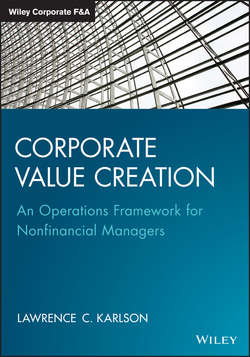Читать книгу Corporate Value Creation - Karlson Lawrence C. - Страница 8
На сайте Литреса книга снята с продажи.
CHAPTER ONE
Basic Concepts 1
ОглавлениеCHAPTER 1 TAKEAWAYS
• There are only two business reasons to own or invest in a company. One is because the company will grow its earnings and therefore value. The other is to receive dividends from the cash flow. In practice, it is often a combination of both.
• Management teams perform better if they are measured against some set of criteria. One of the criteria that is of interest to investors is the return provided by funds invested in the business. A measurement of this is Return on Capital Employed (ROCE).
• In a general sense, managers are tasked with two key objectives: (1) Find attractive investments, and (2) deliver attractive returns. Since ROCE compares what management delivers (Net Operating Profit after Tax) to what has been invested in the company (Capital Employed), it is a good measure of management's effectiveness.
• In some instances, a decline in cash flow can be avoided by cutting costs. In fact, management can increase cash flow by disinvesting in the business. However, in today's business climate, increasing cash flow by expense control doesn't work for very long. Eventually cost cutting is a dead end and the only remaining road to increasing shareholder value is growth. Growth opportunities don't just come along. A company has to be committed to investing for growth in order to get it and even then success is highly uncertain. Unlike sustaining investments, investments focused on growth inherently involve more risk. The upside is, of course, the possibility of a better return.
• Making a choice between sustaining or growth investments or investing for both is not simply a matter of money. In practice it (money) frequently turns out to be the least important resource. Investments directed at growth require ideas and sometimes new technologies. Furthermore, it's not very often that a management team that is outstanding when it comes to cost control and optimizing the productive level of sustaining investments is also good at managing a company for growth. While managing the process and resources associated with putting a company on a growth track can be learned, it takes time – often lots of time and many lessons learned. In practice, most companies make both sustaining and growth investments at the same time. Successful companies have learned that each category of investment has its own prerequisites and culture and therefore staff and manage accordingly.
• The key drivers of Cash Flow are Net Income, Investments, and Return on Capital Employed.
• Without Net Income, a company doesn't generate any cash from operations.
• The first thing that one should notice when examining a Cash Flow Statement is that “Cash” is missing. The reason for this is when it comes to the Cash Flow Statement the “Change in Cash” is what the statement determines.
• When considering the impact that Working Capital has on the Cash Flow Statement, it's the changes (Δ) in the various accounts that are important.
